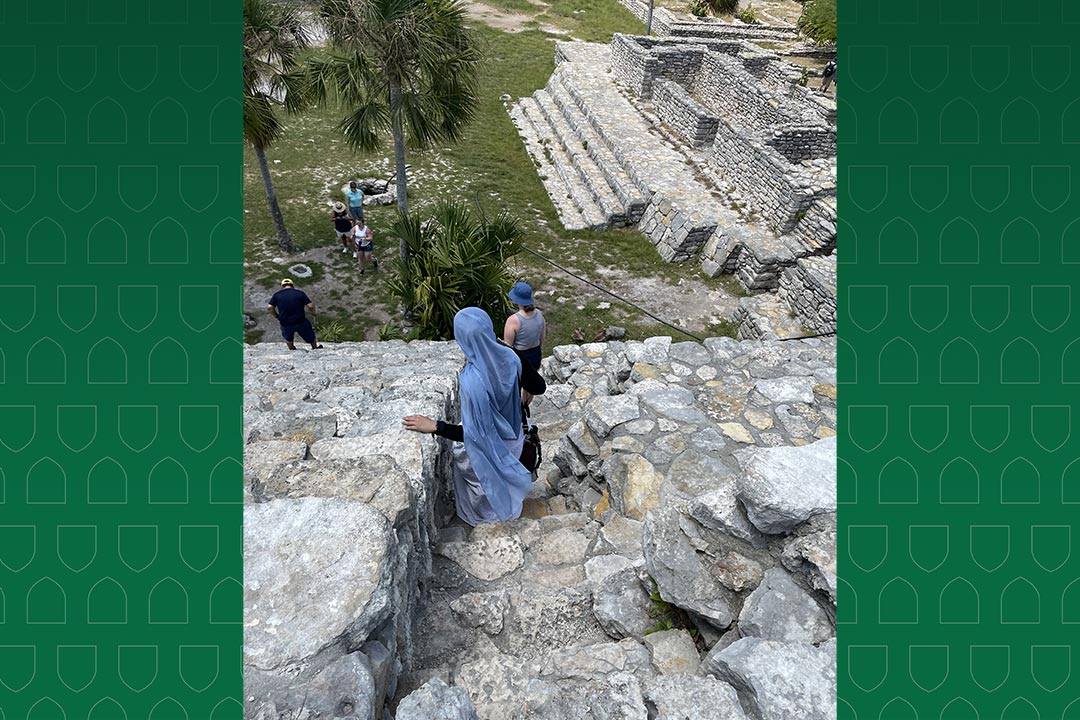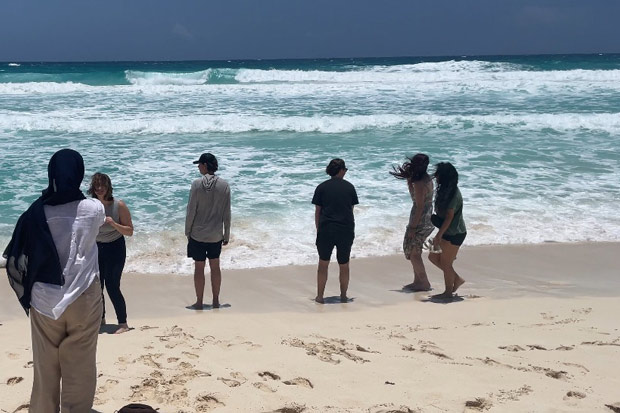
USask students learn about Mayan people and culture in new study abroad course
Study abroad student ambassador Kathryn Sawatzky reflects on an adventure in Mexico
Watch a video of this taught-abroad course on the @USaskArtSci Instagram
By Kathryn Sawatzky, Study Abroad Student Ambassador and Logistics Coordinator for INDG 298
Located in the heart of the Yucatán Peninsula, Mérida is a city rich in culture and history. Twenty University of Saskatchewan students recently embarked on a journey this spring to “La Ciudad Blanca” (The White City) to complete the new College of Arts and Science course INDG 298: Indigenous Colonial and Contemporary Yucatan Mexico.

The two-week taught-abroad course, led by Department of Indigenous Studies assistant professor Dr. Leonzo Barreno (PhD), was designed in conjunction with the Universidad Autónoma de Yucatán (UADY) to teach our students about the Mayan Indigenous people of Mexico.
The class is one of 12 taught-abroad courses managed by the Arts and Science Study Abroad Office happening this spring and summer. This project was partially funded by the Government of Canada’s outbound student mobility pilot program, Global Skills Opportunity (GSO). GSO is designed to foster experiential learning in Canadian students while travelling to unfamiliar countries. Our brilliant students blew me away with their takeaways from what we were taught, including connections and differences to the Indigenous peoples of Canada. I give full credit for every connection made to the students and give my immense gratitude especially to the Indigenous students who so graciously shared aspects of their culture with me and others in our group. All other knowledge expressed in this article is attributed to Dr. Barreno, teaching assistant Adriana Juarez, our tour guide Francisco Gonzalez, and our student guides from UADY, Katia Cristina López Lara and Jorge Patricio Cervera Castilla.
The students participated in a balanced mix of classroom instruction and discussion, independent secondary-source research, and sightseeing complete with information from our tour guides. They also completed almost daily Spanish classes at UADY, and it was delightful to see them starting to be able to order at restaurants or pay for souvenirs in Spanish. Students participated in multiple group projects where they worked together to present to the class about things they had observed and researched. One of the students’ main takeaways was that Spanish colonialism has left an enormous legacy on the Mayan people and culture, much like the British impact on Canada’s Indigenous people. We saw many Catholic structures that had been constructed using the stones that used to belong to Mayan religious structures. In the city of Izamal, about 45 minutes from Mérida, we saw a Spanish cathedral that had been constructed on top of a Mayan pyramid. At the archeological site X’Cambó, a Christian cross stood next to tall Mayan ruins, showing how invasive the Spanish were on Mayan life.
620640jpg

Our students were introduced to many aspects of Mayan culture, including food, architecture, art and games. Some of the things we learned about are no longer pertinent pieces of everyday Mayan life, but others carry more contemporary weight. We travelled to one of the wonders of the world, Chichén Itzá, where we learned about a traditional Mayan game called Pok ta Pok. Anthropologists have determined that the game was played by the elite, with either the captain of the winning or losing team being sacrificed at the end of the game to give thanks for the harvest of the season. We were lucky enough to witness a modern-day version (no sacrificing involved, of course!) in Mérida, where two teams competed to get a rubber ball through a hoop without using their hands or feet. Our guides told us that these modern-day games are mostly performative, often sponsored by the government to share this aspect of culture. Still, it was an incredible game to watch, and we enjoyed hearing about the traditional version and seeing the modern version. The display of culture using a performative game is rather typical in Mérida. There were free events every night showcasing Mayan practices.
In the city of Izamal, we were treated to a feast by the gastronomy students and alumni of the Universidad Technológica del Centro. We were able to choose a drink to start, between jamaica (iced hibiscus tea), horchata (cold cinnamon milk drink), and limonada (lemonade). We were served salbutes to start: crispy round tortillas topped with lettuce, pickled onions, chicken, and tomato. We also got to try kibis, which are an appetizer comparable to falafel that come from Lebanese and Syrian cuisine. Many people from these two countries immigrated in the 13th century to Mérida, and this food was used to help them integrate into Mexican life. Our main course was a variety of tacos covered in sauce, including one called papadzules, which are tacos filled with chopped hard boiled eggs covered with a sauce made of ground pumpkin seeds and tomato. Our meal was so delicious, and we cannot thank the university enough for its amazing hospitality. We are grateful we got to learn so much about traditional dishes and taste them at the same time.

Our students observed that as much as we personally were able to learn about and celebrate Mayan culture, there is not a lot of opportunity for Mayans themselves to benefit from the display of their traditions. Many archeological sites like X’Cambó are owned by the government, and money from tourism does not go toward Mayans themselves. The remaining Christian influence in places like Izamal celebrates Catholicism and the harms that have been done to the Mayans. Even the Mayan World Museum we visited had a heavy focus on Spanish colonialism, and we could not find information about whether this museum gives back to the Mayan people or not. Many students observed that in Canada, we might consider that Indigenous rights are being fought for much more than Indigenous rights in other countries. There is still enormous work that still needs to be done in Canada, but the students said that they did not realize how different the reality can be for Indigenous people elsewhere.
One of the last things students reflected on is that they felt extremely safe in Mérida. This does not match what many of our students have been told about Mexico. A narrative is often painted about the country that we decided is not true everywhere you go. Many said that there are aspects of Canadian cities that feel unsafe, but this narrative is not as widespread. There are safety precautions that need to be taken no matter where you are, and we agreed that we would encourage people to think before spreading harmful stereotypes about different countries. It is important to do research on where you are travelling so you can be adequately prepared, not fearful.
640jpg
620640jpg
640jpg

An immense amount of gratitude is due to our friends at UADY and everyone who was involved in the planning and execution of INDG 298. A huge thank you goes to our friends at UADY: Mtra. Fabiola de Arana Evia, Paola Acosta Vázquez, Fátima Uicab Pratts, Mtra. Julia Puerto Cervera, and Dra. Karina Abreau Cano. Thank you to our amazing drivers who got us to all our destinations safely. We had an amazing two weeks in Mérida and will never forget all we learned.
Together we will support and inspire students to succeed. We invite you to join by supporting current and future students' needs at USask.


